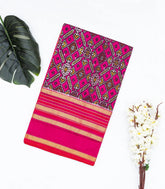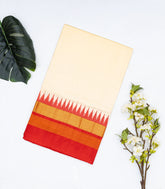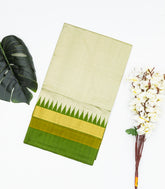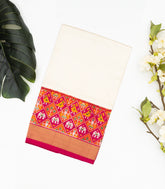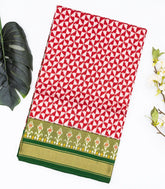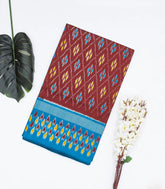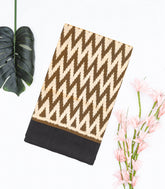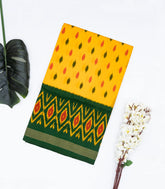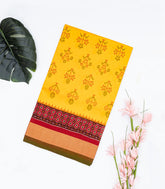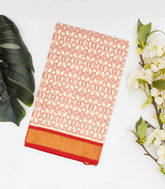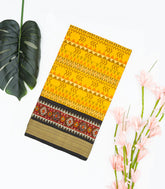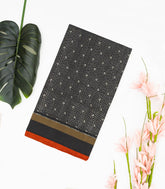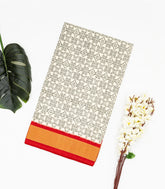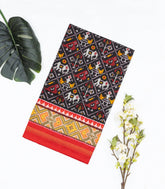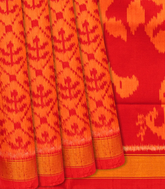-
Pink Handloom Ikat Silk Saree With Tie & Dye Floral Motifs
This handwoven single ikat silk saree is filled with floral motifs in pink body along with border and palluMRP:- ₹20,880
- ₹20,880
- Unit price
- per
-
Cream Handloom Ikat Silk Saree With Contrast Red Border
This handwoven single ikat silk saree is filled with plain cream body along with contrast red border and palluMRP:- ₹11,160
- ₹11,160
- Unit price
- per
-
Light Green Handloom Ikat Silk Saree With Contrast Green Border
This handwoven single ikat silk saree is filled with plain light green body along with contrast green border and palluMRP:- ₹11,160
- ₹11,160
- Unit price
- per
-
White Handloom Ikat Silk Saree With Contrast Pink Border
This handwoven single ikat silk saree is filled with white body along with elephant motifs in contrast pink border and palluMRP:- ₹18,900
- ₹18,900
- Unit price
- per
-
Red Handloom Ikat Silk Saree With Contrast Green Border
This handwoven single ikat silk saree is filled with triangle motifs in red body along with contrast green border and palluMRP:- ₹19,440
- ₹19,440
- Unit price
- per
-
Maroon Handloom Ikat Silk Saree With Contrast Blue Border
This handwoven single ikat silk saree is filled with floral motifs in maroon body along with contrast blue border and palluMRP:- ₹11,160
- ₹11,160
- Unit price
- per
-
Dark Olive Handloom Ikat Silk Saree With White Chevron Motifs
This handwoven single ikat silk saree is filled with white chevron motifs in dark olive body along with border and palluMRP:- ₹8,132
- ₹8,132
- Unit price
- per
-
Yellow Handloom Ikat Silk Saree With Triangle Motifs
This handwoven single ikat silk saree is filled with triangle motifs in yellow body along with contrast green border and palluMRP:- ₹11,160
- ₹11,160
- Unit price
- per
-
Yellow Handloom Ikat Silk Saree With Floral Motifs
This handwoven single ikat silk saree is filled with floral motifs in yellow body along with contrast red border and palluMRP:- ₹24,660
- ₹24,660
- Unit price
- per
-
Cream Handloom Ikat Silk Saree With Floral Motifs
This handwoven single ikat silk saree is filled with floral motifs in cream body along with contrast red border and palluMRP:- ₹24,300
- ₹24,300
- Unit price
- per
-
Yellow Handloom Ikat Silk Saree With Contrast Black Border
This handwoven single ikat silk saree is filled with diamond motifs in yellow body along with contrast black border and palluMRP:- ₹24,300
- ₹24,300
- Unit price
- per
-
Black Handloom Ikat Silk Saree With Broken Stripes
This handwoven single ikat silk saree is filled with broken stripes in black body along with border and palluMRP:- ₹24,300
- ₹24,300
- Unit price
- per
-
White Handloom Ikat Silk Saree With Contrast Red Border
This handwoven single ikat silk saree is filled with floral motifs in white body along with contrast red border and palluMRP:- ₹24,300
- ₹24,300
- Unit price
- per
-
Black Handloom Ikat Silk Saree With Contrast Red Border
This handwoven single ikat silk saree is filled with elephant motifs in black body along with contrast red border and palluMRP:- ₹23,400
- ₹23,400
- Unit price
- per
-
Orange Handloom Rajkot Patola Silk Saree With Floral Jaal Motifs-Orange
This handwoven rajkot patola ikat silk saree with tie & dye floral motifs in orange body along with border and palluMRP:- ₹17,100
- ₹17,100
- Unit price
- per
Subscribe To Our Newsletter
Receive early access to new arrivals, sales, exclusive content, events and much more!


